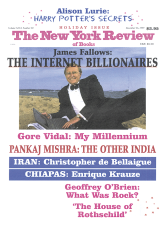In response to:
The Best He Could Do from the October 21, 1999 issue
To the Editors:
In his piece “The Hemingway Tragedy” [NYR, October 21] Thomas Flanagan writes as follows of Hemingway’s unfinished drafts of The Garden of Eden, totalling over 2,000 pages: “As we are told by a scholar who has examined the manuscript, it is ‘often more reiterative than cumulative, containing immense repetition that Hemingway seems to have been unable to control.”‘ After writing this critical view of Hemingway’s version Flanagan goes on to praise the editor Tom Jenk’s (“dazzling…a gem”) truncated version of Eden. But Flanagan fails to ask whether the 247-page Scribner version truly represents Hemingway’s own vision of The Garden of Eden.
In 1986, after Scribner published its cut-and-paste version, the Kennedy Library finally received permission to let permitted scholars view Hemingway’s massive original manuscript. At that time scholars weren’t allowed to xerox or reproduce any of the original text. As I wasn’t a Hemingway scholar, but an outsider merely writing one piece on Eden (for The New Republic), I was in no way dependent on following the rules set down by the Hemingway foundation—I wasn’t going to need their resources or blessings for a possible future book. The librarian at the Kennedy (I sensed she felt the viewing of the real Eden was too restrictive) murmured to me that though pages could not be xeroxed, no restrictions had been placed on the use of cassette machines. I then spent about a week using one. This gave me an opportunity to study later in a more leisurely fashion what Eden was about.
The value of the original version is as a record of Hemingway’s inner artistic voyage. Hemingway emphatically did not want to write a beachy, youthful novel, which would have meant returning to “early Hemingway.” Flanagan rightly observes that Hemingway was interested in Proust. According to the original Eden he was painfully aware of what Proust had accomplished, and read him fairly early on. But the two writers had very different aesthetics. To create his hoped for universal magnum opus Hemingway drew his inspiration, as he previously had done, from art. He turned to the Hieronymus Bosch triptych The Garden of Eden. Eden starts in the south of France and seems to end up as a fiesta at the Prado. The main characters—two artists, two writers and their wives—become part of an endless chain of erotic lovemaking fused with art. One key to the work is Ovid’s Metamorphoses; Picasso, portrayed in the manuscript as working on the one hundred engravings (the Vollard Suite) he made for Ovid’s Metamorphoses, is also part of the chain. No editor could have finished Eden for the troubled Hemingway, but it would have been nice if there had been an Edmund Wilson to have done a selective “Crack-Up,” so that we could know what he had been aiming for.
Barbara Probst Solomon
New York cultural correspondent
El País (Madrid)
Thomas Flanagan replies:
On the closing page of The Sun Also Rises Brett tells Jake that they could have had a damned good time together, and Jake says, in the novel’s closing line, “Isn’t it pretty to think so?” In much the same spirit, I agree with Barbara Probst Solomon that it would have been “nice” had there been an Edmund Wilson to have made judicious and representative selections for us from the two thousand manuscript pages of The Garden of Eden. It is interesting to learn from her that Hemingway’s thematic and structural resources there include Proust, Ovid’s Metamorphoses, and Picasso’s engravings for them, and Bosch’s The Garden of Eden. This does indeed raise the possibility that he had in mind “an endless chain of erotic lovemaking fused with art”—a kind of daisy chain stretching from Paris to the Prado. As she says, he was troubled in mind and spirit, but who knows?
Although editors and critics of Wilson’s tact and standards are in short supply these days, it may still be possible for Hemingway’s publishers to give us some equivalent of The Crack-Up. It would not be a best seller, but after True at First Light they may owe it to him.
This Issue
December 16, 1999



